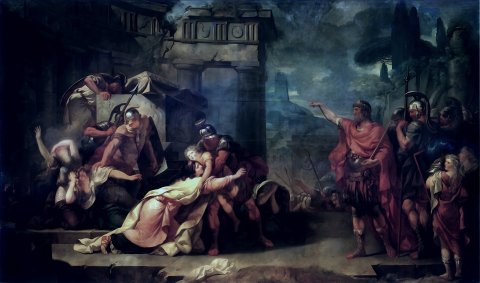Andromache weeping before Ulysses - Doyen
Notice précédente Notice n°51 sur 77 Notice suivante
Description
Booklet from the 1763 Salon:
"By M. Doyen, Académicien.
120 Andromache, having hidden Astianax, Hector's only son, in his father's tomb, to hide him from the concern the Greeks had for him despite their victory, & even though he was only a child: the contrary winds opposing their return after the ruin of Troy; Calchas declared that Astianax should be hurled from the top of the walls, lest one day he avenge his father's death. Ulysses, entrusted with the task of searching for him, discovered him and carried out Calchas' orders. The Painter has captured the moment when Andromache is making her last efforts to snatch her son from the hands of a Soldier; but her cries cannot prevent the execution of Ulysses' orders. He orders him to be thrown from the Tower of Illion.
This Painting, 21 feet wide by 12 feet high, belongs to the Infant Dom Philippe, Duke of Parma & Guastalle."
Mercure de France, November 1763:
"Along with all Amateurs of the glory of Art, we have already applauded M. Doyen's fine fire & courageous emulation. It is with new pleasure that we see him continue to exercise himself in the greatest genre & on Subjects borrowed from the greatest Painter in Poetry.(a)
That of this year's Tableau, is the moment when Uysse has just dragged Astianax from his Father's Tomb, & when he commands to precipitate this Child from the top of the walls, despite the cries & all the efforts of Andromache to snatch her son from the hands of the Soldier who has seized him. (b)
The composition of this painting is unquestionably one of the greatest machines undertaken in painting. The Author, either to make it more distinct, or for some other reason unknown to us, seems to have divided his Scene into two Parts. An empty & quite considerable interval separates Ulysses & his retinue, from the groups formed by Andromache with her followers, Astianax, her captors, &c. To understand how this gap is created, it is necessary to know that the site on which the characters in the action are located is much higher than the distant plane where the troops of soldiers appear in the middle, with only the tops of their heads visible. Connoisseurs, as well as those who judge only by natural feeling, will always be equally pleased with the great & touching expression that reigns in the whole part that includes the groups of Andromache & her Followers. One recognizes & must be penetrated by the beautiful intention that characterizes above all Andromaque's grief. Warmth and sentiment may not have allowed the painter to preserve a sort of subordinate proportion between the expressive signs of this main figure and those of the women accompanying her: but the more we know about the great expression of the pathetic in painting, the more beautiful things we will find to notice in this part of the picture. The other part, where we see Ulysses, at the head of the Army Chiefs, giving the barbaric order which is the point of the Action, could perhaps give rise to more criticism. We won't undertake to discuss it. Full of his Subject, full of the sublimity of his Poet, of the character of the Characters, it would not be surprising if the Painter had exaggerated the attitudes a little; & if the wisdom & the graces of the proportions had not yielded sometimes, as well as the truth of the local colors, to the fire of the inspiration. We do not think we will be denied by anyone, not even by his rivals, in giving just praise to the beautiful genius of this Artist, & in exhorting him even more than ever, by an application worthy of his great talents, to bring perfection in practice, to the same degree of elevation that we recognize in his thoughts.
This great Piece is the only one of its kind in the world. This great Piece is the only Work by Mr. Doyen to have been exhibited this year. The grandeur of the Subject & the merit of the genre, compensate for the number." (p. 188-191)
(a) Homer.
(b) This Painting is 21 feet wide by 12 feet high. It belongs to the Infant Duke of Parma.
3. Châteaubrun had a Astyanax performed at the Théâtre Français, on January 5, 1756: despite the success of Châteaubrun's previous plays, Philoctète and Les Troyennes, the play fell at the first performance. See Corr. litt., January 15, 1756, ed. Tourneux, t. III, p. 156.
Technical Data
Notice #000746



